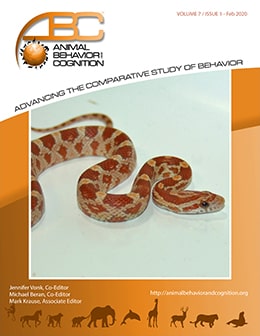Vol 7, Issue 1, February 2020
Visual Discrimination Accuracy across Reaction Time in Rats
Citation
Kurylo, D. D., Lin, C., & Ergun, T. (2020). Visual discrimination accuracy across reaction time in rats. Animal Behavior and Cognition, 7(1), 23-38. doi: https://doi.org/10.26451/abc.07.01.03.2020
Abstract
Processing time, computational load, and stimulus strength interact in perceptual decisions. Studies with non-human primates and rodents have demonstrated that perceptual decisions are guided by stimulus processing as well as cognitive factors, such as decision confidence. For both olfactory and visual discrimination, mice and rats demonstrate a trade-off between accuracy and speed, which is mediated by the level of difficulty and amount of sampling time. In order to investigate the relationship between performance and response time for an discrimination task in which rats controlled trial initiation, response frequency and accuracy were measured across reaction time (RT). Rats discriminated visual patterns consisting of solid-lines (low computational load) or dot grids (high load). Stimulus contrast and duration were varied across conditions. Results indicated a peak function across RT with two phases: an earlier component where accuracy improved to a peak level, followed by a later component where accuracy remained stable or declined. For the earlier phase, reduced salience slowed processing with higher computational load. Unexpectedly, peak performance with highly salient stimuli occurred more quickly with higher computational load. For the later phase, accuracy did not benefit from longer RT, but instead progressively declined. Pre-peak characteristics suggest that accuracy benefits from increased stimulus processing time and is consistent with computational models of progressive accumulation of stimulus information. Post-peak characteristics may reflect factors associated with perceptual decision, such as uncertainty, which delays committing to a response. Results thereby suggest separate effects of stimulus processing and perceptual decision on discrimination accuracy across RT.
Keywords
Animal behavioral assessment, Animal psychophysics, Perceptual grouping, Processing latency
